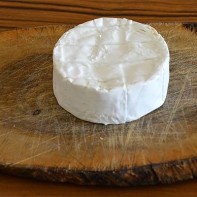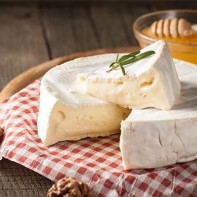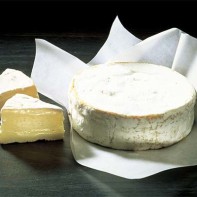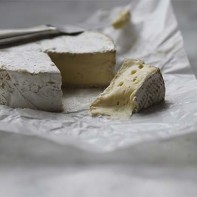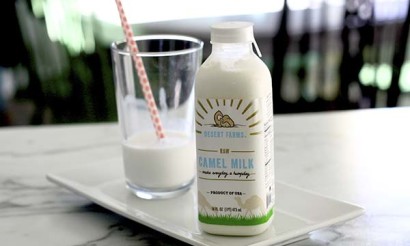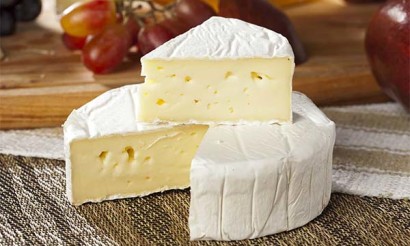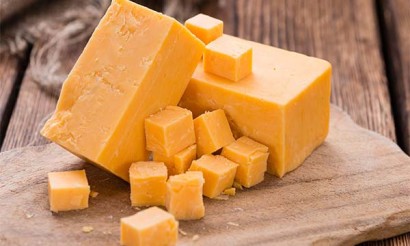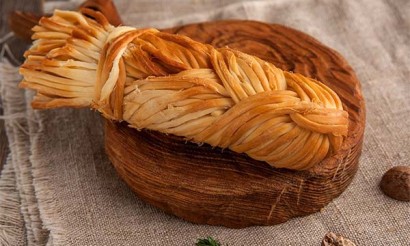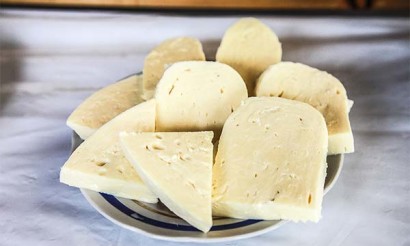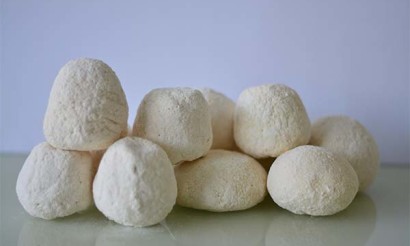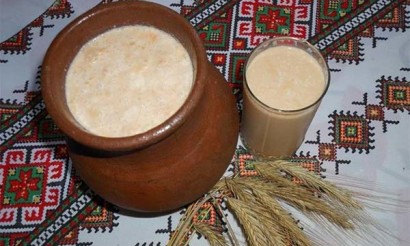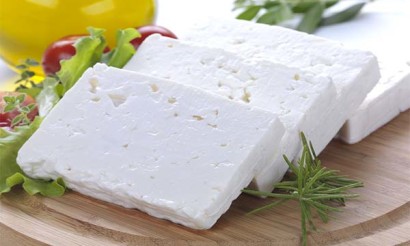Camembert cheese: composition, beneficial properties and contraindications
The favorite cheese of the French bohemia in popularity surpassed even the Brie, to which it owes its appearance. As scientists from Turkey found out, the moldy crust contains microorganisms that are part of the beneficial microflora of the intestine.
- Camembert cheese: what it is, what it is made of and what it tastes like
- History of origin
- Production technology
- Varieties
- What real cheese looks like
- What are they made of?
- What does it taste like?
- What it smells like
- Why Camembert is bitter
- The difference between Brie and Camembert
- Which one tastes better and is healthier?
- Composition and Calories
- What is the usefulness of white mold camembert cheese?
- Can children eat, pregnant and lactating women
- Hazards and contraindications
- How to choose and store
- Can I freeze?
- How to know when Camembert is bad
- Where to buy and how much costs.
- How and with what you eat Camembert cheese.
- Rules of serving
- What does it go with?
- What Wine to match the Cheese
- Cooking Applications
- How to Make Camembert Cheese at Home
- What to cook with Camembert: Recipes
- Salad
- Tart
- Pasta
- Cheese Sauce
- Baked Camembert
- What can be substituted in recipes
- Interesting facts
Camembert: what is it, what is it made of, and what does it taste like?
The main production of soft fat cheese is in May-September. Relatively young, but one of the best-selling varieties in France, it comes in the form of a round tortilla 3.1 cm high, 11.3 cm in diameter.
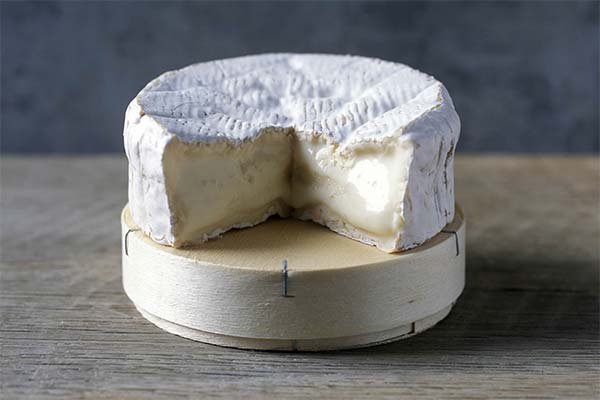
A delicate dairy product with a rich flavor, the odor of stale is completely covered by a dense crust, with white mold growing on it.
History of Origin
The homeland of the cheese is the French village of the same name in Normandy, famous for Calvados, apple cider. The origin of the product is associated with the peasant Marie Arel, who sheltered a priest who fled from the repression of the new revolutionary government.
In gratitude for his saved life, Charles Jean Bonvoiste gave his mistress the recipe for the amazing cheese with a moldy crust. The dairy product for sale was first made by Marie under the direction of the fugitive in 1791. The villagers immediately liked the delicacy, but it did not spread across the country until 70 years later, thanks to active market promotion by Marie's grandson. Camembert became world famous at the end of the 19th century. This event was preceded by engineer Riedel's invention of a container for transportation - a birch-bark round box in which the delicacy retained its shape well.
Camembert got its modern look after 1970. At first the cheese crust was spotted, grayish-blue or brownish.
Production technology
The production of camembert includes several stages:
- Pasteurization of raw materials, introduction of sourdough. The milk is heated up to 75°C. It is cooled down to 32 degrees Centigrade in the recovery section and transferred to tanks, where bacterial sourdough in an amount of 1.5-2% of the total volume is introduced. Milk with sourdough is kept for at least two hours until the acidity reaches 21-22 ° T.
- The formation of a clot. The milk is heated to a clotting temperature of 32 ° C. Add calcium chloride at the rate of 25 g per 100 liters. Then the liquid is directed to the two-section baths, where rennet and mold cultures are automatically fed. The quantity of additives is determined according to the quality and maturity of the milk.
- Clot cutting. The clot is cut into cubes of 1.5 by 1.5 cm, after 15 minutes reciprocating motion makes a retraction. A container with cheese grains and greenish whey overturned in the hopper. From the clot is fed in batches on the conveyor belt to remove the whey, getting the cheese dough.
- Shaping. The forming of dough takes place in cylindrical forms, 60 cm high. At the bottom of the machine are knives, which cut the cheese at a specified height. The self-pressing process lasts 8 hours at a temperature of 25°C. During this time the cylindrical moulds are turned 4 times.
- Salting and drying. The cheese is salted for half an hour in a 20% solution at 15°C. Then the cheese is set at an incline in the support frames. Leave for 8 hours to drain the brine.
- Maturation. Russian Camembert can mature for up to 10 days, French Camembert for up to 25 days. The cheese is transported to a room with a temperature of - 14°C, humidity of 90%. As soon as the white mold mycelium forms (day 3-4), the cheese heads are turned over to spread evenly over the entire surface. After 10-14 days, the cylinders are packed in paper and sent for sale or in storage at a temperature of 4 degrees.
Varieties
Varieties, styles of noble cheese:
Camembert
Cheese with this name is allowed to be produced in any country without standard restrictions. There are two requirements for the dairy product - a hard crust with white mold, consistency like the original camembert.
Camembert de Normandie AOC
Produced exclusively in Normandy from raw milk of local cows. It is characterized by a distinctly unpleasant odor.
Camembert Fabrique en Normandie
This delicacy is made in Normandy, but not from raw milk, but from pasteurized milk. The cheese has a less bright smell than Camembert de Normandie AOC.
What real cheese looks like
Signs of quality Camembert:
- A dense, moldy cheese crust of even white color, sometimes with brownish streaks.
- On cut, the flesh is stained light yellow.
- The core is soft, liquidish, the edges are more solid.
- Shape - a low cylinder weighing 130-340 g.
- Packed in a round birch bark box.
If you keep the cheese at room temperature for a long time, it can leak. This is not a sign of spoilage, but a confirmation of quality.
What is it made of
Cow's (sometimes goat's) milk fresh or pasteurized, rennet, Penicillium Candidum mold, lactic acid bacteria, and salt are used in making camembert.
How it tastes
Camembert is described as delicate, fatty, creamy, sweet with a hint of mushroom and mold. The more the cheese is aged, the brighter the taste and the more salt is felt. If the product is bitter and there are predominant notes of mold, it means that the cheese is spoiled, it is better to refuse to eat it.
How it smells
Flavor depends on the conditions of cows and technological features of production. Classic Camembert smells of stale, fresh mushrooms, smells of earth, hay, barnyard.
The ammoniacal smell is unacceptable, as it is a sign of spoilage.
Why Camembert is bitter
The delicacy product can be bitter for several reasons:
- Feeding cows silage;
- water on the moldy crust;
- violations of cooking techniques.
Bitterness in taste is felt if an excessive amount of calcium chloride has been added to the milk.
On change in taste affects the maturation period. Bitter cheese is overripe, in which the process of decay of proteins has started.
What's the difference between brie and camembert
In France, camembert is called the son of brie because it is produced from it. Both cheeses are soft cheeses, made from cow's milk, but there are still differences between them.
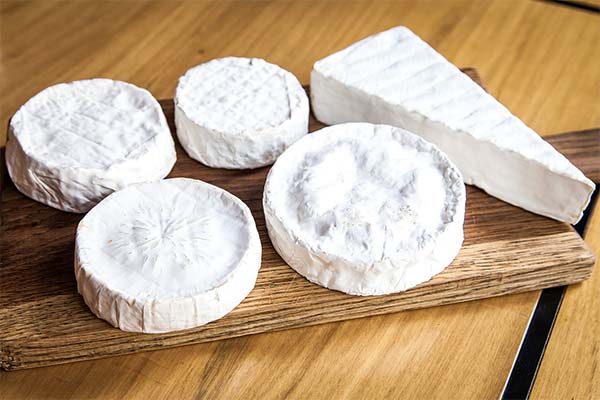
- Camembert is white to ivory on the outside and yellow on the cut. Brie has a grayish-white color and a white, creamy color on the slice.
- The shape of Camembert is a cylinder 3.1 cm high, 11.3 cm in diameter. Brie is a disc 3-5 high, 30-60 cm in diameter.
- The cheeses also differ in taste. Taste, aroma Brie - spicy, combining spiciness and tenderness, brackish with aromas of hazelnuts. Cap flavor is neutral, smells like ammonia alcohol. Camembert - delicate, sweet with the aroma of fresh mushrooms. The crust is sharp with a smell of stale.
Camembert is kept at room temperature before eating, as the product freezes in the refrigerator. Chilled brie retains flavor, aroma, does not change the consistency.
Which is tastier and healthier
It is impossible to say definitively which cheese tastes better, they are different. Camembert is more fatty, delicate and sweet. Brie is tangy with a nutty aftertaste.
Camembert surpasses Brie in the content of vitamins A, D, beta carotene, pantothenic and nicotinic acids, calcium, chlorine, copper, zinc. Brie has more amino acids, cobalamin, thiamine, riboflavin, potassium, magnesium and iron.
Composition and calories
Camembert is rich in proteins, vitamins B12, A, PP, riboflavin, folate. The cheese includes saturated and unsaturated fatty acids Omega-3, 6, calcium, phosphorus, sodium, chlorine, selenium, zinc.
Content of vitamins, minerals in 100 g of camembert:
Vitamins:
- Cobalamin - 0.001 mg;
- A - 0.3 mg;
- PP - 5.6 mg;
- Riboflavin, 0.4 mg;
- Pantothenic acid, 1.1 mg;
- Folates, 0.06 mg;
- Pyridoxine, 0.3 mg;
- Biotin - 0.006 mg;
- Calciferol - 0.001 mg;
- Beta carotene, 0.2 mg;
- Thiamine, 0.05 mg;
- Choline, 0.02 mg;
- Tocopherol, 0.3 mg;
- Ascorbic acid, 0.4 mg.
Micronutrients:
- Zinc - 3.5 mg;
- Selenium - 0.02 mg;
- Copper - 0.06 mg;
- Manganese - 0.04 mg;
- Iron - 0.3 mg.
Macronutrients:
- Sodium - 800 mg;
- Chlorine - 1,233 mg;
- Calcium - 510 mg;
- Phosphorus - 390 mg;
- Sulfur, 153 mg;
- Magnesium - 15 mg;
- Potassium - 75 mg.
GI of 100 g of cheese - 15.3, 28.8, 0.1 g, respectively. Energy value - 324 kcal.
What is the usefulness of Camembert cheese with white mold
Dairy product, rich in amino acids, healthy fats, vitamins and minerals supports the function of blood vessels, heart, musculoskeletal system. The white mold on the crust participates in the synthesis of melanin, restores the normal intestinal microflora, increases its peristalsis.
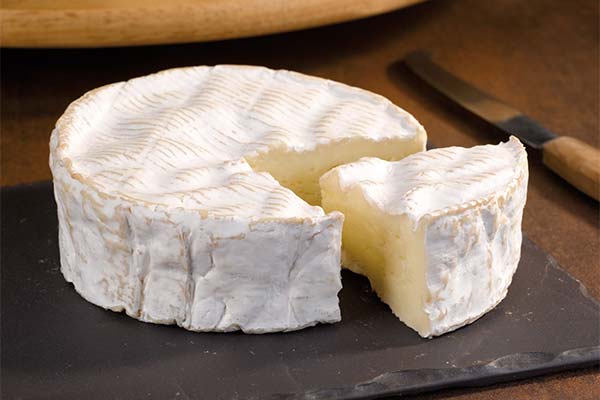
Other beneficial effects of camembert:
- Strengthens the immune system.
- Supports the health of the organs of vision, skin, reproductive functions.
- Speeds healing of fractures, reduces symptoms of arthritis, arthritis.
- Calms the nervous system.
- Prevents tooth decay, osteoporosis.
- Increases hemoglobin.
- Participates in muscle contraction, metabolism of proteins, fats, carbohydrates.
- Regulates the acid-alkaline balance.
- Increases stress resistance.
- Fights chronic fatigue.
- Improves digestion.
- Normalizes sleep.
Delicacy product is useful for anemia, exhaustion, tuberculosis, severe physical, mental stress.
Can I eat children, pregnant and lactating women
Soft cheese with mold can contain listeria, which causes the dangerous disease listeriosis, which is accompanied by muscle pain, colic, vomiting, stool disorders. Pregnant women with weakened immune defenses and people with gastrointestinal tract problems especially exhibit symptoms of the disease.
Doctors advise to exclude cheese from the diet of children, pregnant and lactating women because of the frequent excess of harmful bacteria in the dairy product. Pregnant women who introduce Camembert into their diet are at risk of fetal abnormalities.
Young children's digestive system is not fully formed, and enzymes are not fully produced. Cheese with mold can cause serious harm to a child under the age of five.
Harms and contraindications
Camembert is contraindicated if individual intolerance, blood cholesterol levels are significantly higher than normal.
With caution, small portions should consume the cheese for people with obesity, stable high blood pressure.
How to choose and store
Do not make a mistake if you buy a product made in Normandy. You won't find a better cheese, especially if the package bears the Camembert de Normandie Appellation d'Origine Controlee au Lait Cru stamp. The inscription means that the cheese is made in a particular region from the best milk.
The crust determines the age of the product. It is tall and white for a cheese aged a week. The older the Camembert, the more the crust sags and red streaks form on the surface. A ripe head has a creamy or yellowish cheese mass.
The best cheese is considered to be in the last 5 days before the expiration date specified by the manufacturer.
The product is stored for up to 7 days at a temperature of 0-10 degrees in the factory packaging with the lid closed (film, cellophane bags are not suitable). To preserve the original flavor and aroma, camembert is kept in the refrigerator away from other products with a pungent smell.
Can I freeze?
The product is frozen if you plan to use it in recipes for more complex dishes. When defrosted, the cheese has a change in structure. It becomes crumbly and less tasty.
Semi-hard cheeses are easier to withstand freezing. Keep camembert in the refrigerator until it is of a suitable consistency before sending it to the freezer. With a sharp knife, cut the head into small pieces, each one wrapped tightly in foil. In this form the product will keep up to six months.
How to tell if camembert has gone bad
Signs of cheese unfit to eat:
- Ammonia-like pungent odor;
- Darkening of color;
- Hard, cracked edges of the crust;
- thickening, excessive growth of white mold;
- bitterness in taste.
An increase in the number of holes indicates improper storage conditions.
Where to buy and how much to pay
The product is sold in chain supermarkets, cheese shops, selling online sites. The price depends on the manufacturer, the place of sale, the composition. The average cost is 750 p. for a 250 gram package.

Top Cheese Manufacturers
The highest quality cheeses are presented on the market:
- Swiss companies Margot Fromages and Mozer, which make aged cheese with a pronounced taste according to European standards.
- French Fromital. The company produces not only quality Camembert, but also its progenitor Brie.
- Finnish Souani. The production is distinguished by its delicate flavor and original packaging.
- Tula company Nenashevo Agro. Consumers note the product's similarity in taste to the French original.
- The Russian company Tocqueville makes a viscous soft cheese that is popular with customers.
- Moscow Treville has been producing several types of cheese with original additives for over 15 years. In the case of camembert, a charcoal sprinkle is used.
- The dairy company Laktomilk LLC produces dessert cheeses under the Chizi brand from fresh whole milk of high quality.
How and with what you eat Camembert cheese
The delicacy tastes better if it has a flowing center, elastic edges. Cheese is used with walnuts, almonds, grapes, sweet fruits, berries. The French eat Camembert with a crispy baguette or dissolve a piece of cheese in a cup with coffee, getting a nutritious, original drink.
Serving rules
Take the product out of the fridge an hour before eating. Cut into slices, like a cake with a knife dipped in hot water, leave it to warm up to room temperature.
This delicacy is served with or without a crust, depending on taste.
The cheese is spread on crackers, fresh bread, or toast. Top with your favorite jam, jam, honey or slices of fruit.
What does it go with?
Camembert harmonizes with sweet, tart, sour, salty products. The cheese perfectly combines with strawberries, cranberries, currants. Sweet berry shades spiciness, and sour ones emphasize creamy flavor.
Spicy herbs spice up the cheese, and walnuts make it more tart.
The product will taste better if eaten with chocolate, honey, melon, sweet grapes, apples, pears.
What wine goes well with cheese
The flavor of aromatic cheeses, which includes Camembert, emphasizes champagne, red young wines. Merlot, Syrah, Pinot Noir, Beaujolais, Gamet, Chardonnay will do.
White and pink wines, on the contrary, dampen the bright flavor of the dessert.
Culinary applications
Camembert is added to soups, salads, pasta, baked meat and fish, prepared sauces. Homemade bread, pizza, sandwiches, pies, or baked in the oven are made with the cheese.
More often the dairy product is served alone or as part of a cheese plate with nuts, fruit, as an appetizer for cider, Calvados, wine.
How to make Camembert cheese at home
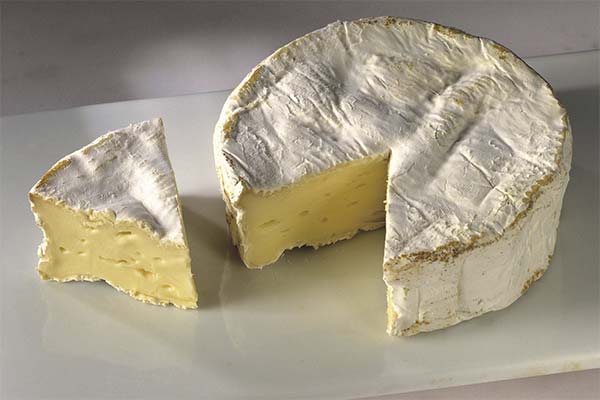
To make 2 heads of delicacy cheese at home, you will need household utensils:
- An enameled or stainless steel saucepan;
- Two cylindrical molds for self-pressing;
- a large food container;
- paper for ripening, storing cheese;
- drainage mat;
- thermometer.
Ingredients:
- 4 liters fresh cow's milk;
- 4 tsp. salt;
- A quarter teaspoon of mesophilic starter;
- 1.2 ml liquid rennet;
- A pinch of Penicillium Candidum mold;
- 0.6 ml of 10 percent sodium chloride.
Preparation Algorithm:
- Pour half a cup of warm water over the starter; let stand for half an hour.
- Pour the milk into a saucepan and place on the stove. Heat to 75 degrees, cool to 32°C.
- Pour in the activated sourdough, add the mold culture. Stir and leave to rest for 30 minutes.
- Dilute a little warm water, calcium chloride and rennet in separate containers. Pour into the pot.
- After an hour, the milk will separate into a plastic clot and whey. Pierce the clot with a knife. If the blade is still clean, start slicing.
- Remove the curd from the container, cut it into 1.5 by 1.5 cm cubes. Stir slowly for a quarter of an hour until the whey has separated.
- Transfer the grains to cylindrical molds. Once the dough has flattened, remove it and flip it over. Continue this action every 30 minutes for three hours.
- For even more compaction, leave the cheese in the self-pressing molds overnight in a 17 degree room.
- Weigh the heads, taking 2% salt. Spread the white crystals over the surface, return the cheese back to the molds for 2 days until dry.
- Transfer the heads to a container with a drainage mat covered with a paper towel. Place in a cool place with a temperature of 10-12 °C.
- For a week, change the napkins daily, on the eighth day, wrap the camembert in special paper, send it to the refrigerator, where the product will stay for 3 weeks until the final maturation.
It will take a month to produce homemade camembert.
What can be cooked with camembert: recipes
Soft cheese is stuffed with dumplings, pies. The product is baked with garlic, spicy herbs or fruit. The noble product adds spice to vegetable and fruit salads, pasta, risotto, baked meat, fish.
Salad
If you want to surprise your guests, serve an exquisite salad with pears and soft cheese.
Products for 4 servings:
- 80 g camembert (brie);
- 2 tsp. lime or lemon juice;
- half a pear;
- 2 handfuls of salad leaves (preferably different varieties);
- 1 tsp. dijon mustard;
- 50 g walnuts;
- 1 tbsp. extra virgin olive oil;
- 0.5 tsp. fresh honey;
- black pepper, salt.
Method of preparation:
- Wash lettuce. Cut cheese into small pieces.
- Make dressing. Combine and mix oil, lime juice, mustard, honey, seasoning.
- Roast nuts in a dry pan. Chop, but not to a crumb.
- Slice the pear, fry for a minute on each side.
- Arrange salad leaves on a platter. Arrange pear slices, cheese. Drizzle with dressing. Sprinkle with nuts.
This original salad will take 10 minutes to prepare.
Pie
Pie with dessert cheese and cherry tomatoes is delicious, takes half an hour to prepare.
Ingredients for 12 servings:
- 0.5 kg of puff pastry without leavening;
- 1 egg;
- 250 g of soft cheese;
- 300 g cherry tomatoes.
Preparation steps:
- From the pastry sheets, cut two circles with a diameter of 22 cm.
- Place the first one on a baking tray lined with parchment. Place a circle of cheese in the center with cherry tomatoes around it.
- Cover the filling with the second pastry piece. Pinch the edges together with wet fingers.
- Prick the entire flatbread with a fork. Brush with beaten egg.
- Bake the cake in an oven for 25 minutes at 190 degrees until golden. Remember to preheat the oven.
To prevent the filling from leaking, slice the pie into portions once it has cooled completely.
Pasta
To make five servings of pasta you need:
- 250 g baked camembert;
- 100g of baked parmesan;
- 400g of pasta;
- 150 gr spinach;
- 2 cloves of garlic;
- rosemary sprig;
- olive oil;
- pepper, salt.
How to prepare:
- Grate Parmesan. Bake camembert with garlic and rosemary in the oven.
- Put a pan of water on the stove. Taste and season with salt and bring to boil. Boil the pasta.
- Add chopped spinach greens to the bowl. After 10-15 seconds, strain in a colander.
- Return the pasta and spinach to the pan, sprinkle with grated Parmesan, pour in the butter, pepper and stir.
When serving, sprinkle melted camembert over the pasta in a bowl.
Cheese Sauce
Camembert sauce retains the mushroom flavor and is used for fondue, fish dishes and as a stand-alone dessert.
Product set:
- 90 g soft cheese;
- Glass of cream;
- 40g butter;
- 1 tbsp. flour;
- ground black pepper.
Melt the butter in a saucepan, fry the flour until brown. Pour in cream, stirring, bring to a boil. Cut cheese into slices, add to casserole, and season with pepper. Continue cooking over low heat until the cheese is melted.
The dish is eaten both warm and chilled. The product is consumed in the next two days, later expires.
Baked Camembert
To bake the cheese, prepare:
- 1 package of camembert;
- 1 tsp. olive oil;
- 1 large garlic clove;
- pepper;
- 2 sprigs each of rosemary, thyme.
Carefully cut off the top crust, return the cheese to the birch bark box, greased with olive oil. Cut the garlic into slices, insert them through the punctures into the dairy product.
Break the thyme, rosemary into small sprigs. Stir them into the cheese. Sprinkle the delicacy with pepper, drizzle with oil. Bake for 20-25 minutes in an oven heated to 180 degrees until the cheese is melted and golden.
What you can substitute in recipes
Russian camembert, which differs in taste from the Normandy, may well replace it in dishes of home cooking.
Other analogues of camembert, suitable for replacement in recipes:
- brie;
- dor-blue;
- livaro;
- pon leveque;
- cambazola;
- danablue;
- cambazolla.
It is impossible to find an exact copy of camembert, because the taste is influenced by the conditions in which the cows are kept and fed. But the noble cheeses listed are the closest to the original.
Interesting facts
Surprising and informative facts about the delicacy of dairy products:
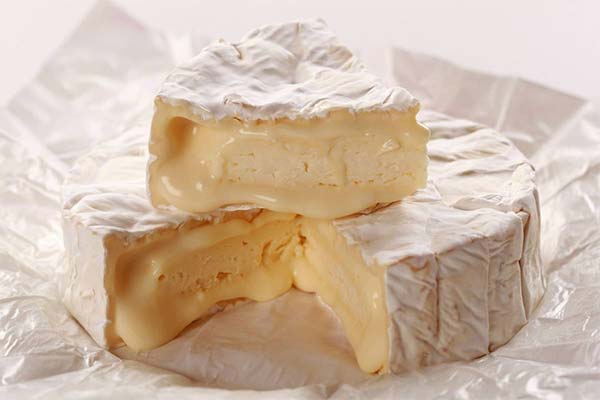
- A runaway priest shared the recipe for brie with the peasant Marie Arel, but because of different climatic conditions, camembert turned out.
- Salvador Dali wrote his famous painting "The Continuity of Memory", which depicts a soft clock, after seeing camembert.
- The taste of the product is so multifaceted that some, in addition to mushroom, feel garlic, herbal, nutty, fruity aftertaste.
The original soft cheese originating from France has a specific aroma, a complex sweetish taste with mushroom notes, contrasting structures. If you eat the product in an amount not more than 50 g, you can improve your mood, maintain health without worrying about the figure.
«Important: All information on the site is provided solely for introductory purposes only. Before applying any recommendations, consult a health care professional. specialist. Neither the editors nor the authors shall be liable for any possible harm caused by materials."


